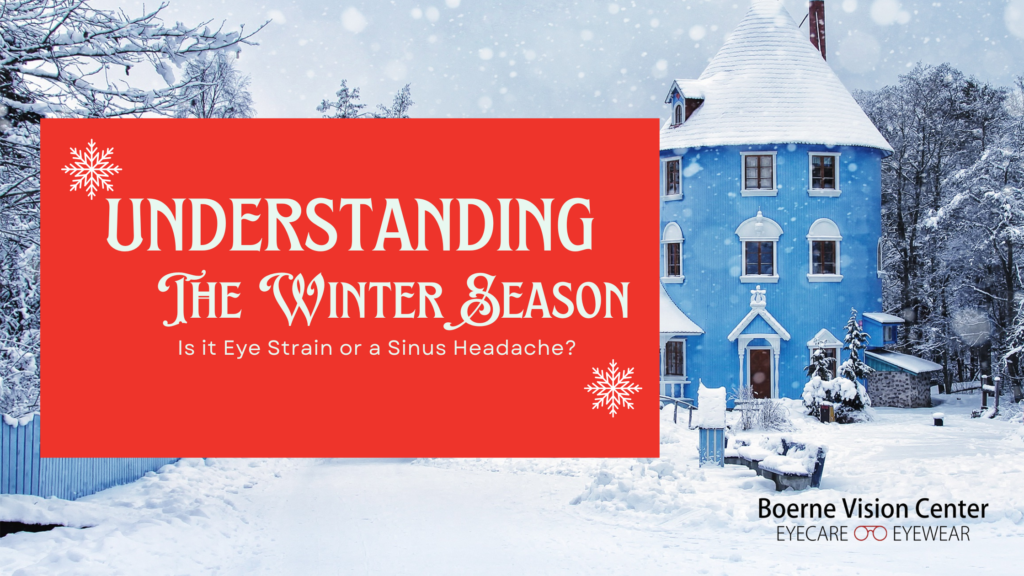Introduction to the Winter Season
Winter, with its picturesque snowflakes and cozy sweaters, also brings unique health challenges. Two notable concerns that often arise are eye strain and sinus headaches. These conditions, while seemingly minor, can significantly impact our daily lives. In this article, we’ll explore how Boerne Vision Center in Boerne, TX, stands as a pivotal resource in managing these winter health issues with their expert optometrists and optical staff.
Two notable concerns that often arise are eye strain and sinus headaches. These conditions, while seemingly minor, can significantly impact our daily lives. In this article, we’ll explore how Boerne Vision Center in Boerne, TX, stands as a pivotal resource in managing these winter health issues with their expert optometrists and optical staff.
Common Winter Health Issues
The winter season, characterized by cold temperatures and reduced humidity, significantly impacts our health, especially concerning our eyes and sinuses. The dry indoor air, a result of heating systems, and the sharp outdoor cold can lead to discomfort in these areas. This is where Boerne Vision Center comes into play, offering specialized care to mitigate these seasonal health challenges.
Understanding Eye Strain
Eye strain, or asthenopia, tends to escalate during the colder months. Factors contributing to this include prolonged screen exposure and the dry, heated indoor air. The optometrists at Boerne Vision Center are well-equipped to diagnose eye strain. They offer professional advice on the best eyewear and lenses, tailored to reduce eye fatigue and strain.
Causes and Symptoms of Eye Strain During Winter
Several factors can cause eye strain during winter. The dry air from indoor heating systems reduces the moisture in our eyes, leading to dryness and irritation. Spending excessive time in front of screens, such as computers and smartphones, can also strain our eyes.  Furthermore, the glare from the snow and bright winter sunlight can stress our eyes.
Furthermore, the glare from the snow and bright winter sunlight can stress our eyes.
Symptoms of eye strain may include dryness, redness, itching, blurry vision, eye fatigue, and headaches. If you experience any of these symptoms during the winter season, taking steps to prevent and manage eye strain is essential.
Tips to Prevent and Manage Eye Strain
To prevent and manage eye strain during winter, consider the following tips:
- Take regular breaks from screens: Every 20 minutes, look away from your screen and focus on an object in the distance for at least 20 seconds.
- Blink frequently: Blinking helps to moisten the eyes and reduce dryness.
- Adjust screen settings: Ensure that your screen brightness, contrast, and font size are comfortable for your eyes.
- Use artificial tears: Over-the-counter artificial tear drops can help relieve dryness and lubricate the eyes.
- Wear sunglasses: Protect your eyes from the glare of the snow and winter sunlight by wearing sunglasses with UV protection.
- Maintain proper lighting: Ensure your workspace is well-lit and balanced with natural and artificial light.
- Use a humidifier: Adding moisture to the indoor air can help alleviate dryness and prevent eye strain.
- Moist heat eye compress: This helps clear oil glands and allows natural oils to flow back onto the eye to relieve discomfort.
By following these tips, you can reduce the risk of eye strain and maintain optimal eye health during the winter season.
Introduction to Sinus Headaches
Sinus headaches are a common problem during the winter season. They occur when the sinuses, air-filled cavities in our skull, become inflamed and swollen.  The changes in temperature and humidity during winter can trigger sinus headaches in individuals prone to such conditions.
The changes in temperature and humidity during winter can trigger sinus headaches in individuals prone to such conditions.
Differentiating Between Eye Strain and Sinus Headaches
Understanding whether a headache is due to eye strain or sinus issues is crucial for effective treatment. While both conditions share similarities, they also have distinct differences. The optometrists at Boerne Vision Center can provide a precise diagnosis, guiding patients towards the appropriate treatment path.
Causes and Symptoms of Sinus Headaches During Winter
The common cold or allergies often trigger sinus headaches during winter. The cold air can cause the blood vessels in the sinuses to constrict, leading to inflammation and pain. Dry indoor air can also irritate the nasal passages and exacerbate sinus headaches. 
Symptoms of sinus headaches may include facial pain or pressure, pain behind or around the eyes, nasal congestion, postnasal drip, fatigue, and a decreased sense of smell. If you experience these symptoms during winter, taking steps to prevent and manage sinus headaches effectively is essential.
Tips to Prevent and Manage Sinus Headaches
Prevention and management of eye strain are key. Simple practices such as regular screen breaks and using humidifiers can make a significant difference. For tailored solutions, including eyewear that minimizes strain, a visit to Boerne Vision Center is highly recommended. Their experts can guide you in choosing the most suitable eyewear for your needs.
- Keep nasal passages moisturized: Use saline nasal sprays or rinses to keep your nasal passages moist and clear.
- Stay hydrated: Drink plenty of fluids to maintain adequate hydration and thin mucus secretions.
- Use a humidifier: Adding moisture to the indoor air can help soothe irritated nasal passages and reduce sinus inflammation.
- Avoid triggers: Identify and avoid any triggers that may worsen your sinus headaches, such as certain foods, allergens, or irritants.
- Practice good hygiene: Wash your hands regularly to prevent the spread of viruses and bacteria that can cause sinus infections.
- Use over-the-counter pain relievers: Non-prescription pain relievers can help alleviate the pain associated with sinus headaches. However, following the recommended dosage and consulting a healthcare professional if the headaches persist is essential.
By incorporating these preventive measures and management techniques into your daily routine, you can minimize the occurrence and severity of sinus headaches during the winter season.
Seeking Medical Help for Persistent Eye Strain or Sinus Headaches
While most cases of eye strain and sinus headaches can be managed with self-care techniques, it is crucial to seek medical help if the symptoms persist or worsen. A healthcare professional can evaluate your condition, diagnose it correctly, and recommend appropriate treatment options.
A healthcare professional can evaluate your condition, diagnose it correctly, and recommend appropriate treatment options.
If you are experiencing persistent eye strain or sinus headaches during the winter season, you should schedule an appointment with an optometrist, your primary care doctor, or an ENT specialist. They can conduct a comprehensive examination and provide personalized recommendations to alleviate your symptoms.
Conclusion
Understanding and managing eye strain and sinus headaches is crucial, especially during the winter months. Boerne Vision Center stands as a beacon of expertise in this area, offering specialized care to ensure optimal eye and sinus health throughout the season. For anyone struggling with these winter woes, a visit to Boerne Vision Center can be the first step towards relief and comfort.
For anyone struggling with these winter woes, a visit to Boerne Vision Center can be the first step towards relief and comfort.
Visit Boerne Vision Center
Don’t let winter ailments dampen your season. Visit Boerne Vision Center for expert care and personalized solutions to ensure a comfortable and healthy winter.


